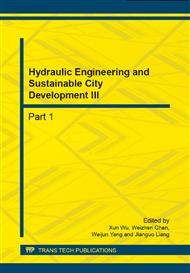[1]
Leitner, A.: The fire catastrophe in the Tauern tunnel: experience andconclusions for theAustrian guidelines. Tunneling and Underground SpaceTechnology 16 (3)(2001), 217–223.
DOI: 10.1016/s0886-7798(01)00042-6
Google Scholar
[2]
Kirkland, C.J.: The fire in the channel tunnel. Tunneling and UndergroundSpace Technology 17 (2)(2002), 129–132.
Google Scholar
[3]
KatjaKircher, Christer Ahlstrom: The impact of tunnel design and lighting on the performance of attentive andvisually distracted drivers. Accident Analysis and Prevention 47 (2012) 153– 161.
DOI: 10.1016/j.aap.2012.01.019
Google Scholar
[4]
Amundsen, F.H., Engelbrektsen, A.: Studies on Norwegian Road Tunnels II. An Analysis on Traffic Accidents in Road Tunnels 2001–2006. Vegdirektoratet, Roads and Traffic Department, Traffic Safety Section, Oslo. (2009).
DOI: 10.1016/s0886-7798(00)00024-9
Google Scholar
[5]
Nussbaumer, C.: Comparative analysis of safety in tunnels. In: YoungResearchers Seminar 2007, Brno.
Google Scholar
[6]
Amundsen, F.H.: Studies of driver behaviour in Norwegian road tunnels. Tunnellingand Underground Space Technology 9 (1), (1994) 9–15.
DOI: 10.1016/0886-7798(94)90004-3
Google Scholar
[7]
Robatsch, K., Nussbaumer, C.: Tunnels mitGegenverkehr und Richtungsverkehr/tunnels with uni- and bi-directional traffic. BundesministeriumfÜr Wissenschaft und Verkehr, Wien. (2004).
Google Scholar
[8]
Horberry, T., Anderson, J., Regan, M.A., Triggs, T.J., Brown, J. Driver distraction: the effects of concurrent in-vehicle tasks, road environment complexity and ageon driving performance. Accident Analysis & Prevention 38, (2006)185–191.
DOI: 10.1016/j.aap.2005.09.007
Google Scholar
[9]
Mccartt, A.T., Hellinga, L.A., Braitman, K.A.: Cell phones and driving: review ofresearch. Traffic Injury Prevention 7 (2), (2006) 89–106.
DOI: 10.1080/15389580600651103
Google Scholar
[10]
Young, K.L., Regan, M.A., Hammer, M.: Driver Distraction: A review of the Literature. Monash University Accident Research Centre, Clayton Campus, Victoria, Australia, (2003).
Google Scholar
[11]
Thiffault, P., Bergeron, J.: Monotony of road environment and driver fatigue: asimulator study. Accident Analysis & Prevention 35 (3), (2003) 381–391.
DOI: 10.1016/s0001-4575(02)00014-3
Google Scholar
[12]
Ting, P. -H., Hwang, J. -R., Doong, J. -L., Jeng, M. -C.: Driver fatigue and highwaydriving: a simulator study. Physiology & Behavior 94 (3), (2008) 448–453.
DOI: 10.1016/j.physbeh.2008.02.015
Google Scholar
[13]
Robinson, G.H., Erickson, D.J., Thurston, G.L., Clark, R.L.: Visual search by automobiledrivers. Human Factors 14 (4), (1972)315–323.
Google Scholar
[14]
Sivak, M.: The information that drivers use: is it indeed 90% visual? Perception25 (9), (1996)1081–1089.
Google Scholar
[15]
Green, P.: Where do drivers look while driving (and for howlong). In: InHumanFactors in Traffic Safety. Lawyers & Judges Publishing Company, Inc., (2002) p.77–110.
Google Scholar
[16]
Van Houten, R., Retting, R.: Increasing motorist compliance and caution at stopsigns. Journal of Applied Behavior Analysis 34, (2001) 185–193.
DOI: 10.1901/jaba.2001.34-185
Google Scholar
[17]
Zhi-gang Du, Xiao-dong Pan, Xue-binGuo. Visual Adaptation Index for Driving Safety at Entrance and Exit of Highway Tunnel. Journal of South China University of Technology (Natural Science Edition) July. 2007 Vol. 35 No. 7, In Chinese.
Google Scholar
[18]
He, C., Chen, B., Wang, J., Shi, Y.: Year Research on allocation ofthe driver's attention on the tunnel sections of a mountain freeway. In: Proceedings of the 10th International Conference of Chinese TransportationProfessionals—Integrated Transportation Systems: Green, Intelligent, Reliable, ICCTP, August 4, 2010–August 8, 2010, Beijing, China, p.444.
DOI: 10.1061/41127(382)48
Google Scholar
[19]
Ying-shiGuo, et al.: Fixation distribution of driver while driving through passageways with different width. Journal of traffic and transportation engineering. Vol. 6 No. 2 , June (2006).
Google Scholar
[20]
Shan Bao, Linda Ng Boyle: Age-related differences in visual scanning at median-divided highway intersections in rural areas. Accident Analysis and Prevention 41 (2009) 146–152.
DOI: 10.1016/j.aap.2008.10.007
Google Scholar
[21]
Wei-hua Zhao, Hao-xue Liu, Guang-ming Ding, et al. : Impact of Expressway Long Tunnel on DriVers. High Way. May. 2011 No. 5 . In Chinese.
Google Scholar
[22]
Wang Xue-song , Shi Qi, GaoZhen. Urban Tunnel Traffic Operating Characteristics and Its Safety Study Based on Surveillance Camera Data. China Safety Science Journal. Vol . 2 1 No. 8 Aug . 2011. In Chinese.
Google Scholar
[23]
Ernst Simonson, Charles Baker, Neal Burns, Charles Keiper, O.H. Schmitt, Stirling Stackhouse. Cardiovascular stress (electrocardiographic changes) produced by driving an automobileOriginal Research Article. American Heart Journal, Volume 75, Issue 1, January 1968, Pages 125-135.
DOI: 10.1016/0002-8703(68)90123-3
Google Scholar
[24]
Jiahui Li, Xiaohua Zhao, ShiliXu et al. The Study of Driving Simulator Validation for PhysiologicalSignal Measures. Procedia - Social and Behavioral Sciences 96 ( 2013 ) 2572 – 2583.
DOI: 10.1016/j.sbspro.2013.08.288
Google Scholar
[25]
Ruixue Fang.: Experimental Research on Effectiveness of Pre-Warning Countermeasure of Driving Fatigue Based on Physiological. (2010)p.28.
Google Scholar
[26]
Kejun Mao: The Study of Driver Fatigue Prediction Based on the EGG Analysis. Ergonomics, 12, (2009). 25-29.
Google Scholar
[27]
David W. Soole, Barry C. Watson, Judy J. Fleiter.: Effects of average speed enforcement on speed compliance andcrashes: A review of the literature. Accident Analysis and Prevention 54 (2013) 46– 56.
DOI: 10.1016/j.aap.2013.01.018
Google Scholar


